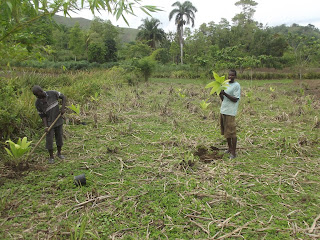 |
| Costa Rica |
They remain popular in some countries of Central and South America.
I, Cory, enjoyed them in Brazil in the early 90's.
After trying many seed suppliers without good results, I finally went to Costa Rica Spring of 2014 to get good seed.
 |
| Costa Rica fruit market |
Close to 700 seeds grew to a good size in the nursery and a few hundred wait to be planted.
The new garden had been growing mostly sugar cane and rice.
The owner does not live nearby and sharecrops with some local farmers.
With the purchase just finalized last week, the local farmer was still in the process of hoeing and planting.
Rice and corn are just coming up.
 |
| 3 truck trips to bring 170 peach palms |
 |
| 8 wheelbaro loads the first day, 2 on the 2nd day. |
The local farmer will continue care for this year's crops and harvest them.
He already asked about continuing to work the land next year.
This will be decided at a later time.
Annual crops will continue to be practical for at least two years.
Some of the palms may start fruiting in three.
The land is medium fertility and part can flood, but peach palms do well on wet land.
The poor drainage area would be a problem for most other crops, but peach palm and acai palm should do great!
A few rambutan and other fruits will be planted for trial in the higher part of the garden.
 |
| Four people planting on 2nd day, should be done the 3rd day |
The best tasting and best producing peach palms will be left to cross pollinate and provide good quality seeds for nursery production and establishing the crop in our area.
The amount of food produced per acre by peach palm tends to be better than corn, where hybrid seed and fertilizer are not available (as is the case here).
The fruit are also more nutritious than corn, with good amounts of protein, oil, starch, and vitamins.
We are praying for a rain soon to soak them in, it will be hard work watering them from the river if it gets dry, a 10-15 minute walk each way.
Some of the nearby farmers are counting on regular rain as they are planting upland rice on hillsides.


2 comments:
Out of curiosity, did you have prior horticultural experience? Or has this all been "on the job" learning? I think it's fascinating!
Cory received a degree in fruit horticulture from Michigan State. Then he interned for one year with ECHO, Educational Concerns for Hunger Organization, based out of Fort Myers, Florida.
Post a Comment